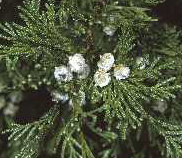 |
On-line Proceedings of the
2009 Atlantic White-Cedar Symposium
The Ecology and Management of
Atlantic White-Cedar (Chamaecyparis thyoides) Ecosystems
A Symposium held on June 9, 10, and 11, 2009 at the
City Hotel and Bistro in Greenville, North Carolina - USA |
Preliminary evaluation of Atlantic White Cedar in a Wastewater Land Treatment System in Onslow County, North Carolina.
Robert T. Belcher, Malcolm Pirnie, Inc.; L. Eric Hinesley, North Carolina State University; Tony R. Rooks, City of Jacksonville, NC; David A. Swain, City of Jacksonville, NC.
Presented by Robert T. Belcher
Acreage of Atlantic white cedar (Chamaecyparis thyoides) (AWC) acreage has declined drastically since European colonization. Re-establishment activities to date have focused on systems known to once support AWC ecosystems including but not limited to peatlands, pocosins, Carolina bays, bogs. The objective of this range finding study was to evaluate the growth and survival of AWC in a Wastewater Land Treatment System in Onslow County, NC. This 2,549-ha (6,300 ac) system, with 913 ha (2,255 ac) under irrigation, is one of the largest of its type in the United States. Historically, AWC was not present within the well drained soils in the irrigation spray fields.
In 2008, 1-year-old containerized AWC (cell volume = 260 cm3 = 16 in3) and bare-root 1-0 loblolly pine (Pinus taeda) seedlings were planted at 2-m (6.6-ft) intervals within four 10 x 10 m (33 x 33 ft) plots at each of three locations. All plots were located within non-jurisdictional uplands but within the wetted area of a sprinkler that sprayed treated wastewater effluent. After one complete growing season, survival for AWC and loblolly pine seedlings was 82% and 70%, respectively. Growth of surviving seedlings was 18.1 cm (7.1 in) for AWC and 8.6 cm (3.4 in) for loblolly pine. Both species were damaged by deer and rabbits (40% for AWC).
This range-finding study suggests that AWC can survive within the Land Treatment System and even potentially outgrow loblolly pine seedlings. A multiple-year study to evaluate survival, growth and confirm the results of this study is recommended.
Proceedings Table of Contents and Conference Links
